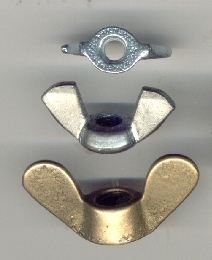
Nuts are a common type of fasteners. Consisting of a piece of metal with a threaded hole, they are used in conjunction with a bolt to hold two or more objects together. The bolt is inserted through the objects, after which a nut is twisted on the end of the bolt, thereby pressing and securing the objects together. There are different types of nuts, however, one of which being the wing nut. What is a wing nut exactly?
The Basics of Wing Nuts
Also known as a butterfly nut, a wing nut is a type of nut that’s characterized by the presence of two tabs. Most types of nuts feature a hexagonal shape. You can install and remove them by turning them. Wing nuts are distinguished from other types of nuts by their use of tabs. As shown in the adjacent photo, they have two tabs. These tabs or “wings” provide gripping surface so that you can easily install and remove them.
How Wing Nuts Work
Wing nuts work like most other nuts: They are designed to hold two or more objects together when used in conjunction with a bolt. You can twist a wing nut onto the end of a bolt to prevent the connected objects from pulling away. Wing nuts feature internal threading, so they can run up and down the bolts with which they are used.
The main benefit of wing nuts, however, is their ease of installation and removal. You can install and remove them more easily than other types of nuts thanks to their wings. Traditional nuts have a hexagonal shape, and with six sides, you may have trouble gripping them. Wing nuts offer a more ergonomic design by providing tabs. Rather than gripping the base of a wing nut, you can grip its two tabs.
Choosing Wing Nuts
When choosing wing nuts, there are several things to consider. Different wing nuts are made of different materials. Some of them are made of stainless steel, whereas others are made of aluminum, copper and other iron alloys.
Wing nuts are also available in several types as classified by the American Society for Mechanical Engineers (ASME). Type A wing nuts, for instance, are cold-forged. Type B wing nuts, on the other hand, are hot-forged. There are also Type C wing nuts that are die-casted, as well as Type D wing nuts that are made via metal stamping.
